初中英语:谈疑问词+动词不定式的用法
疑问词加动词不定式
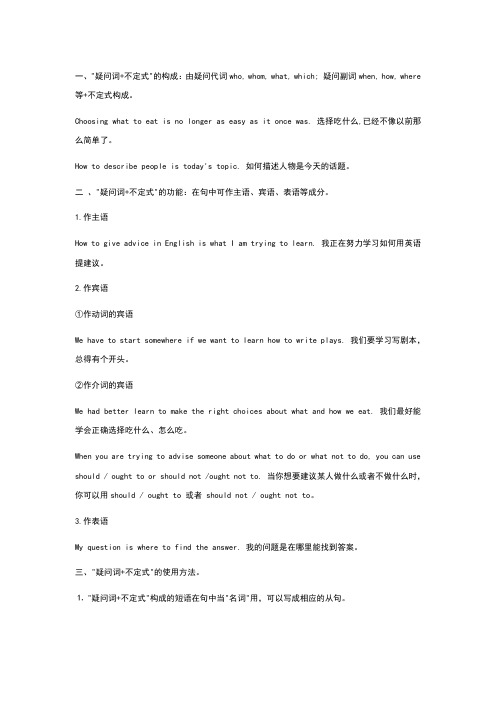
一、"疑问词+不定式"的构成:由疑问代词who, whom, what, which; 疑问副词when, how, where 等+不定式构成。
Choosing what to eat is no longer as easy as it once was. 选择吃什么,已经不像以前那么简单了。
How to describe people is today's topic. 如何描述人物是今天的话题。
二、"疑问词+不定式"的功能:在句中可作主语、宾语、表语等成分。
1.作主语How to give advice in English is what I am trying to learn. 我正在努力学习如何用英语提建议。
2.作宾语①作动词的宾语We have to start somewhere if we want to learn how to write plays. 我们要学习写剧本,总得有个开头。
②作介词的宾语We had better learn to make the right choices about what and how we eat. 我们最好能学会正确选择吃什么、怎么吃。
When you are trying to advise someone about what to do or what not to do, you can use should / ought to or should not /ought not to. 当你想要建议某人做什么或者不做什么时,你可以用should / ought to 或者 should not / ought not to。
3.作表语My question is where to find the answer. 我的问题是在哪里能找到答案。
三、"疑问词+不定式"的使用方法。
初中英语关于动词不定式的用法详解
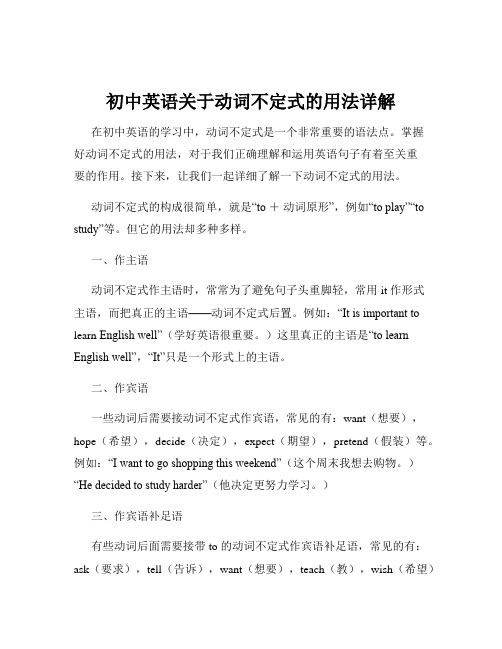
初中英语关于动词不定式的用法详解在初中英语的学习中,动词不定式是一个非常重要的语法点。
掌握好动词不定式的用法,对于我们正确理解和运用英语句子有着至关重要的作用。
接下来,让我们一起详细了解一下动词不定式的用法。
动词不定式的构成很简单,就是“to +动词原形”,例如“to play”“to study”等。
但它的用法却多种多样。
一、作主语动词不定式作主语时,常常为了避免句子头重脚轻,常用 it 作形式主语,而把真正的主语——动词不定式后置。
例如:“It is important to learn English well”(学好英语很重要。
)这里真正的主语是“to learn English well”,“It”只是一个形式上的主语。
二、作宾语一些动词后需要接动词不定式作宾语,常见的有:want(想要),hope(希望),decide(决定),expect(期望),pretend(假装)等。
例如:“I want to go shopping this weekend”(这个周末我想去购物。
)“He decided to study harder”(他决定更努力学习。
)三、作宾语补足语有些动词后面需要接带 to 的动词不定式作宾语补足语,常见的有:ask(要求),tell(告诉),want(想要),teach(教),wish(希望)等。
例如:“My mother asks me to clean the room”(我妈妈叫我打扫房间。
)“The teacher tells us to read more books”(老师告诉我们要多读些书。
)四、作定语动词不定式作定语时,要放在被修饰的名词或代词之后。
例如:“I have a lot of homework to do”(我有很多作业要做。
)“There is no timeto waste”(没有时间可以浪费了。
)五、作状语1、目的状语动词不定式可以用作目的状语,表示某一动作或行为的目的。
谈疑问词+动词不定式的用法学习资料

谈疑问词+动词不定式的用法谈疑问词+动词不定式的用法在英语中,疑问词+动词不定式的用法较为普遍,现在将其归纳如下:“疑问词+动词不定式”结构中的疑问词,包括疑问代词what which who 和疑问副词when how where 等。
这些疑问词和不定式一起构成了不定式短语,这种结构在句子中除了不能作谓语外,可做主语、宾语、表语等。
例如:1. She didn’t know which bus to take.她不知乘哪路公共汽车。
(做动词宾语)We must first solve the problem of whom to serve.我们必须首先解决为谁服务的问题。
(做介词宾语)2. When to start remains undecided.何时出发,尚未决定。
(做主语)3. The difficulty is how to do the most of work with theleast of money.困难是如何尽量少用钱多办事。
(做表语)这种结构相当于一个名词从句,不论它在句子中做什么成分,常常都可用同等成分的从句替代。
改为从句时只要在疑问词后面填加一个适当的主语并将不定式动词改为适当形式的谓语既可。
所以上述几句可分别改成:She didn’t know which bus she should take.We must first solve the problem of whom we should serve.When we should start remains undecided.The difficulty is how we ought to do the most of word withthe least of money.当这种结构做宾语的时候,常常置于show, find out, learn, teach, tell, advise, wonder, know, discuss, remember, forget, explain 等动词之后。
特殊疑问词+动词不定式结构

“特殊疑问词+不定式”的用法“疑问词+不定式”结构(question word + to-infinitive)4)疑问代词who, what, which等与疑问副词when, where, how等后面跟不定式,以及连接副词whether 与不定式连用构成不定式短语(在作用上相当于一个名词性从句,名词成分)。
这种结构在句中可作主语、宾语、表语、复合宾语的直接宾语、状语、同位语等句子成分。
注意:疑问副词why后不能跟动词不定式一、“疑问词+不定式动词”结构的几种功用:1)作主语Where to go is still a question、到哪里去还就是个问题。
(作主语时,谓语动词常用单数形式)When to hold the meeting has not yet been decided、Choosing what to eat is no longer as easy as it once was、选择吃什么,已经不像以前那么、、、When to start has not been decided、何时动身尚未决定。
What to read is an important question、该读些什么就是一个很重要的问题。
How to begin is more difficult than where to stop、如何开始比到哪里停止还困难。
2)作宾语(作用相当于名词性从句)A、用作动词宾语He asked how to open the box、她询问如何打开盒子。
She couldn’t think what to say、她想不出说什么。
He could not tell whom to trust、Our teacher explained how to use the word processor、老师向我们说明如何使用文字处理机。
I know where to find the boy、我知道到哪里能找到这个男孩。
“特殊疑问词+动词不定式”的用法归纳

“特殊疑问词+动词不定式”的用法归纳一.由两部分构成:疑问词和动词不定式(wh-+to do)。
疑问词部分包括疑问代词who, whom, what, which和whose以及疑问副词when, where和how。
此外,连接词“whether”也适用.它主要具有以下几种功能:⑴当主语,如:● When to hold the meeting has not yet been decided.● Where to live is a problem.⑵当宾语,常接在forget, find out, discuss, decide, tell, teach, know, learn, wonder, remember等动词之后作宾语如:● We must know what to say at a meeting.● He could not tell whom to trust.● Do you know how to play bridge?⑶当表语,如:● The problem is where to find the financial aid.● The question is who to elect.⑷当名词同位语,如:● Tom had no idea which book to read first.● The question whether to confess troubled the girl.⑸用于宾语补足语,双重宾语。
某些动词后可接“sb.+ 疑问词 + 不定式”构成的双重宾语,这类动词常用的有advise, ask, show, teach, tell等如:● I can tell you where to get this book.● I ask her how to learn English.● He will advise you what to do.● Will you show me how to use the machine?(6) 作介词宾语:某些介词后面可接"疑问词+不定式"作宾语,这类介词常用的有about, as, from, in, of, on, with等。
动词不定式与疑问词的搭配
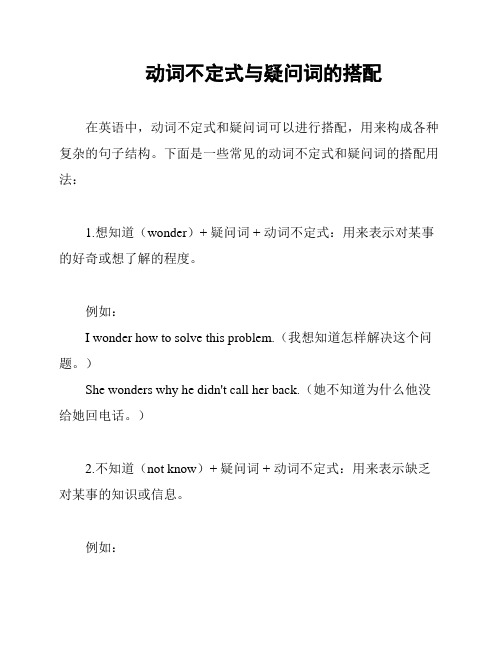
动词不定式与疑问词的搭配在英语中,动词不定式和疑问词可以进行搭配,用来构成各种复杂的句子结构。
下面是一些常见的动词不定式和疑问词的搭配用法:1.想知道(wonder)+ 疑问词 + 动词不定式:用来表示对某事的好奇或想了解的程度。
例如:I wonder how to solve this problem.(我想知道怎样解决这个问题。
)She wonders why he didn't call her back.(她不知道为什么他没给她回电话。
)2.不知道(not know)+ 疑问词 + 动词不定式:用来表示缺乏对某事的知识或信息。
例如:I don't know what to wear for the party.(我不知道该穿什么去参加聚会。
)___'t know where to find the key.(他不知道在哪里找到钥匙。
)3.问自己(ask oneself)+ 疑问词 + 动词不定式:用来表示自问自答的思考过程。
例如:I asked myself whether I should take the job offer or not.(我问自己是不是应该接受这份工作邀请。
)She asked herself why she was ___.(她在思考为什么自己感觉那么累。
)4.解释(explain)+ 疑问词 + 动词不定式:用来解释某事的原因或目的。
例如:___.(他解释了自己为什么迟到开会。
)___ how to use the new are.(她解释了如何使用这个新软件。
)动词不定式和疑问词的搭配用法丰富多样,上述只是其中的一部分例子。
通过灵活运用这些搭配,可以使句子更加丰富和表达更多的信息。
初中英语动词不定式用法梳理解读
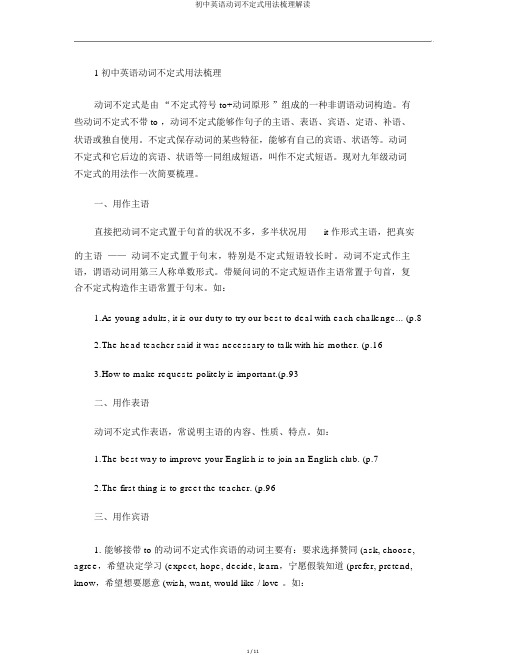
1初中英语动词不定式用法梳理动词不定式是由“不定式符号 to+动词原形”组成的一种非谓语动词构造。
有些动词不定式不带 to ,动词不定式能够作句子的主语、表语、宾语、定语、补语、状语或独自使用。
不定式保存动词的某些特征,能够有自己的宾语、状语等。
动词不定式和它后边的宾语、状语等一同组成短语,叫作不定式短语。
现对九年级动词不定式的用法作一次简要梳理。
一、用作主语直接把动词不定式置于句首的状况不多,多半状况用it 作形式主语,把真实的主语——动词不定式置于句末,特别是不定式短语较长时。
动词不定式作主语,谓语动词用第三人称单数形式。
带疑问词的不定式短语作主语常置于句首,复合不定式构造作主语常置于句末。
如:1.As young adults, it is our duty to try our best to deal with each challenge... (p.82.The head teacher said it was necessary to talk with his mother. (p.163.How to make requests politely is important.(p.93二、用作表语动词不定式作表语,常说明主语的内容、性质、特点。
如:1.The best way to improve your English is to join an English club. (p.72.The first thing is to greet the teacher. (p.96三、用作宾语1. 能够接带 to 的动词不定式作宾语的动词主要有:要求选择赞同 (ask, choose, agree,希望决定学习 (expect, hope, decide, learn,宁愿假装知道 (prefer, pretend, know,希望想要愿意 (wish, want, would like / love 。
带有特殊疑问词的不定式

不定式与疑问词不定式可以和疑问代词who, what, which及疑问副词when, how, where等连用,构成不定式短语,在句子中作主语、宾语、表语等。
现将这种用法归纳如下。
一、“疑问词+动词不定式”结构有两种形式:1. “疑问词+to+动词原形”I don’t know what to say. 我不知道说什么。
Can you tell me how to make a paper boat?你能告诉我怎样做一只纸船吗?2. “疑问词+名词+to+动词原形”I don’t know which topic to choose. 我不知道选哪个题目。
二、“疑问词+动词不定式”结构中的疑问词,包括疑问代词who, what,which 和疑问副词how, when, where等。
这些疑问词和不定式一起构成了不定式短语,这种结构可在句子中作以下成分:1. 主语Where to stay for the night is a problem. 晚上在哪儿过夜还是个问题。
What to do is not decided yetHow to begin is more difficult than where to stop2. 宾语We must know how to operate the machine. 我们必须弄懂如何操作这机器。
In one of his books, Marx gave some advice on how to learn a foreign language.在马克思的一本书中,他对如何学习一门外语提出了一些建议。
(作介词on的宾语)Do you know when to start? 你知道什么时候开始吗?I showed her which button to press. 我告诉她应该按哪一个按钮。
、有时还可用于介词后作宾语。
如:I found a book on how to avoid having a heart attack. 我找到一本书谈如何避免心脏病复发。
疑问词加不定式的用法
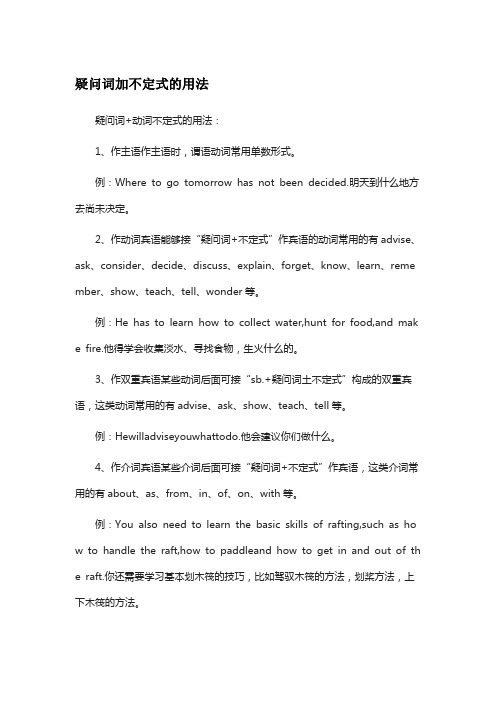
疑问词加不定式的用法疑问词+动词不定式的用法:1、作主语作主语时,谓语动词常用单数形式。
例:Where to go tomorrow has not been decided.明天到什么地方去尚未决定。
2、作动词宾语能够接“疑问词+不定式”作宾语的动词常用的有advise、ask、consider、decide、discuss、explain、forget、know、learn、reme mber、show、teach、tell、wonder等。
例:He has to learn how to collect water,hunt for food,and make fire.他得学会收集淡水、寻找食物,生火什么的。
3、作双重宾语某些动词后面可接“sb.+疑问词土不定式”构成的双重宾语,这类动词常用的有advise、ask、show、teach、tell等。
例:Hewilladviseyouwhattodo.他会建议你们做什么。
4、作介词宾语某些介词后面可接“疑问词+不定式”作宾语,这类介词常用的有about、as、from、in、of、on、with等。
例:You also need to learn the basic skills of rafting,such as ho w to handle the raft,how to paddleand how to get in and out of th e raft.你还需要学习基本划木筏的技巧,比如驾驭木筏的方法,划桨方法,上下木筏的方法。
5、作表语。
例:Perhaps the most difficult challenge is how to survive witho ut friends.也许最难熬的挑战,就是生活中孤独无友。
注意:1、并非所有动词都适用于“疑问词+不定式”结构,主要有know、see、decide、tell、ask、consider、discover、explain、forget、learn、rem ember、wonder、understand等。
疑问词+动词不定式的用法

疑问词+动词不定式的用法疑问词+动词不定式的结构在英语中被广泛用于提问或表达疑虑。
它由一个疑问词(例如what, when, where, why, how等)和动词不定式(即to + 动词原形)组成,用来询问某个动作、目的、原因或方式。
这个结构常用于以下几种情况:1. 目的(Purpose):询问某个动作的目的或原因。
例句:- Why did you come to the party?(你为什么来参加这个聚会?)- What do you want to buy?(你想买什么?)2. 方式(Manner):询问某个动作的方式或方法。
例句:- How did you solve the problem?(你是如何解决这个问题的?)- In what way can I assist you?(我可以以什么方式帮助你?)3. 时间(Time):询问某个动作发生的时间或顺序。
例句:- When do you plan to start your new job?(你打算什么时候开始新工作?)- At what time did the event begin?(活动是什么时候开始的?)4. 地点(Place):询问某个动作发生的地点。
例句:- Where do you want to go for vacation?(你想去哪里度假?)- To which country would you like to immigrate?(你想移民到哪个国家?)5. 原因(Reason):询问某个动作发生的原因。
例句:- Why did she quit her job?(她为什么辞职了?)- For what reason did they cancel the meeting?(他们取消会议的原因是什么?)需要注意的是,疑问词+动词不定式通常用于疑问句中,而不是陈述句或祈使句。
在使用时,我们可以根据具体情况选择合适的疑问词,并结合动词不定式来表达自己的问题或疑虑。
特殊疑问词动词不定式的用法归纳
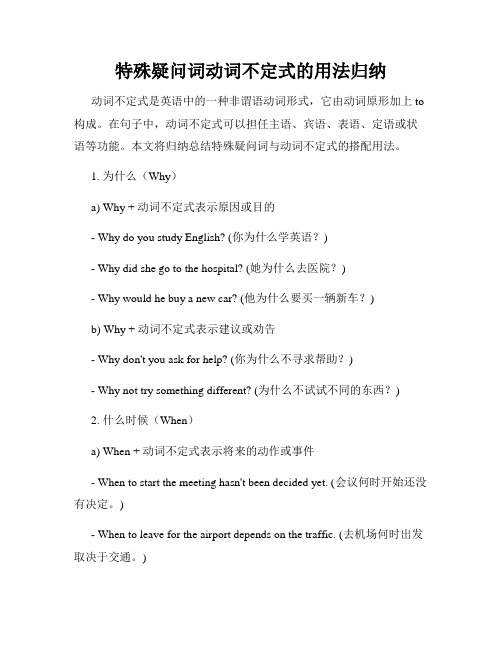
特殊疑问词动词不定式的用法归纳动词不定式是英语中的一种非谓语动词形式,它由动词原形加上to 构成。
在句子中,动词不定式可以担任主语、宾语、表语、定语或状语等功能。
本文将归纳总结特殊疑问词与动词不定式的搭配用法。
1. 为什么(Why)a) Why + 动词不定式表示原因或目的- Why do you study English? (你为什么学英语?)- Why did she go to the hospital? (她为什么去医院?)- Why would he buy a new car? (他为什么要买一辆新车?)b) Why + 动词不定式表示建议或劝告- Why don't you ask for help? (你为什么不寻求帮助?)- Why not try something different? (为什么不试试不同的东西?)2. 什么时候(When)a) When + 动词不定式表示将来的动作或事件- When to start the meeting hasn't been decided yet. (会议何时开始还没有决定。
)- When to leave for the airport depends on the traffic. (去机场何时出发取决于交通。
)3. 如何(How)a) How + 动词不定式表示方式、方法或方式- How to solve this problem is yet to be determined. (如何解决这个问题还没有确定。
)- How to use this machine is explained in the manual. (如何使用这台机器在说明书中有解释。
)4. 为何(Why)a) Why + 动词不定式表示目的- Why take the risk if it's unnecessary? (如果没有必要,为什么冒险?) - Why waste time on something that doesn't matter? (为何在无关紧要的事情上浪费时间?)5. 何时(When)a) When + 动词不定式表示计划或打算- When to meet again will be discussed at the next meeting. (何时再次见面将在下次会议上讨论。
(完整版)特殊疑问词+动词不定式结构
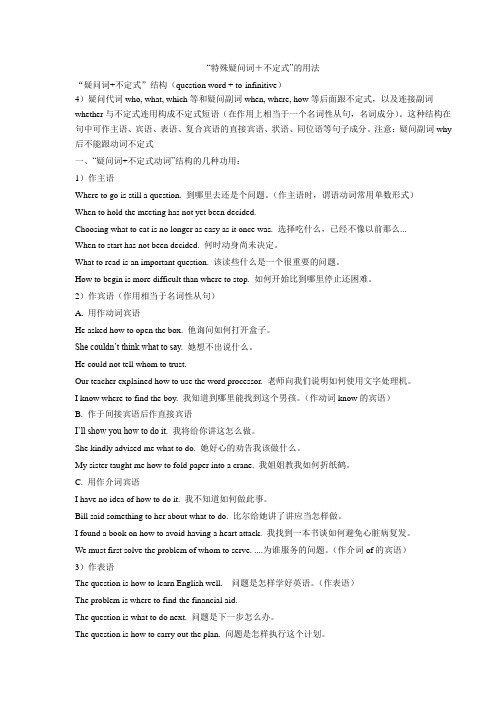
“特殊疑问词+不定式”的用法“疑问词+不定式”结构(question word + to-infinitive)4)疑问代词who, what, which等和疑问副词when, where, how等后面跟不定式,以及连接副词whether与不定式连用构成不定式短语(在作用上相当于一个名词性从句,名词成分)。
这种结构在句中可作主语、宾语、表语、复合宾语的直接宾语、状语、同位语等句子成分。
注意:疑问副词why 后不能跟动词不定式一、“疑问词+不定式动词”结构的几种功用:1)作主语Where to go is still a question. 到哪里去还是个问题。
(作主语时,谓语动词常用单数形式)When to hold the meeting has not yet been decided.Choosing what to eat is no longer as easy as it once was. 选择吃什么,已经不像以前那么...When to start has not been decided. 何时动身尚未决定。
What to read is an important question. 该读些什么是一个很重要的问题。
How to begin is more difficult than where to stop. 如何开始比到哪里停止还困难。
2)作宾语(作用相当于名词性从句)A. 用作动词宾语He asked how to open the box. 他询问如何打开盒子。
She couldn’t think what to say. 她想不出说什么。
He could not tell whom to trust.Our teacher explained how to use the word processor. 老师向我们说明如何使用文字处理机。
I know where to find the boy. 我知道到哪里能找到这个男孩。
初中英语语法“动词不定式”用法

浅析初中英语语法“动词不定式”的用法摘要:初中英语语法中,动词不定式(infinitive)是一个重要的语法知识点,也是中考的必考考点之一。
动词不定式没有人称和数的变化,在句中不能独立作谓语;但动词不定式具有名词、形容词和副词特征,在句中可以作主语、宾语、宾语补足语、定语、表语和状语等多种成分。
关键词:动词不定式特征用法疑问不定式在英语中,动词有限定性动词和非限定性动词两种,非限定性动词(verbal)有动词不定式、动名词和分词三种。
限定性动词在句子中可以单独作谓语动词,非限定动词在句子中不能单独作谓语动词。
动词不定式(infinitive)是一种非限定动词,由动词不定式符号to加动词原形构成。
下面我们来谈谈动词不定式的特征以及动词不定式的用法。
一、动词不定式的特征1.如果动词不定式是及物的,须带宾语。
如:he wanst to stduy french.动词不定式tostduy后面有宾语french)2.动词不定式可以被状语修饰.如:he wanst to stduy french well.3.动词不定式没有人称和数的变化,即不受主语的人称和单、复数的限定或影响.如:marci seems to know everything4.其否定形式是在不定式符号to前面加not. i decided not to work in this factory any longer.5.不定式的逻辑主语常用or或of结构引出。
如:for a child to have his own free time is very necessary.二、动词不定式的用法动词不等式具有名词、形容词和副词的特征,因此它在句子中可以主语、宾语、表语、定语和状语。
(一)不定式作主语1.to learn out of the window is dangerous(把身子伸出窗外是危险的)2.to die for the people is a glorious death!(为人民而死,虽死犹荣)动词不定式作主语时,常用it作形式主语,而将动词不定式结构放在系表结构(be+adj.)的后面,主要是为了保持句子的平衡。
初中英语动词不定式的用法小结
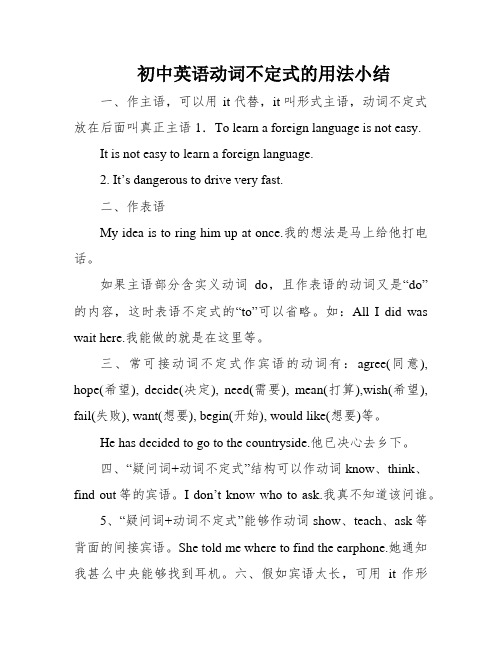
初中英语动词不定式的用法小结一、作主语,可以用it代替,it叫形式主语,动词不定式放在后面叫真正主语1.To learn a foreign language is not easy.It is not easy to learn a foreign language.2. It’s dangerous to drive very fast.二、作表语My idea is to ring him up at once.我的想法是马上给他打电话。
如果主语部分含实义动词do,且作表语的动词又是“do”的内容,这时表语不定式的“to”可以省略。
如:All I did was wait here.我能做的就是在这里等。
三、常可接动词不定式作宾语的动词有:agree(同意), hope(希望), decide(决定), need(需要), mean(打算),wish(希望), fail(失败), want(想要), begin(开始), would like(想要)等。
He has decided to go to the countryside.他已决心去乡下。
四、“疑问词+动词不定式”结构可以作动词know、think、find out等的宾语。
I don’t know who to ask.我真不知道该问谁。
5、“疑问词+动词不定式”能够作动词show、teach、ask等背面的间接宾语。
She told me where to find the earphone.她通知我甚么中央能够找到耳机。
六、假如宾语太长,可用it作形式宾语,组成“主语+谓语+ it +宾语缺乏语(名词或描述词) + to do sth”布局,谓语动词常为find、think、feel等。
I found it difficult to stop him.我发现拦截他很艰巨。
七、动词不定式可以作介词的宾语。
XXX is about to start.秋收即将开始。
疑问词+不定式结构
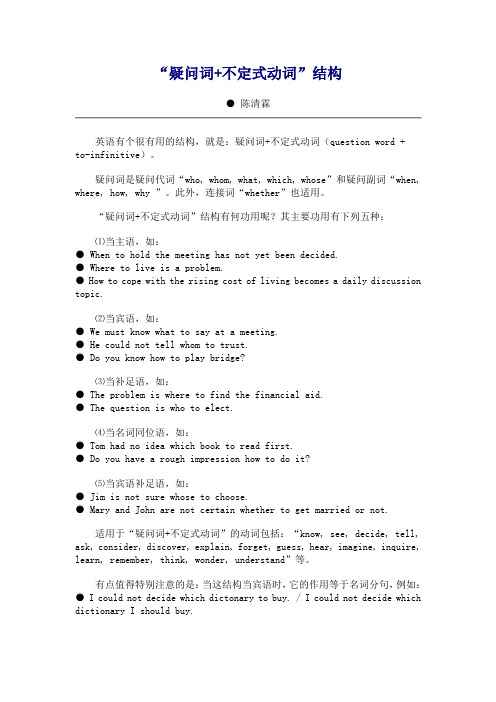
“疑问词+不定式动词”结构● 陈清霖英语有个很有用的结构,就是:疑问词+不定式动词(question word +to-infinitive)。
疑问词是疑问代词“who, whom, what, which, whose”和疑问副词“when, where, how, why ”。
此外,连接词“whether”也适用。
“疑问词+不定式动词”结构有何功用呢?其主要功用有下列五种:⑴当主语,如:● When to hold the meeting has not yet been decided.● Where to live is a problem.● How to cope with the rising cost of living becomes a daily discussion topic.⑵当宾语,如:● We must know what to say at a meeting.● He could not tell whom to trust.● Do you know how to play bridge?⑶当补足语,如:● The problem is where to find the financial aid.● The question is who to elect.⑷当名词同位语,如:● Tom had no idea which book to read first.● Do you have a rough impression how to do it?⑸当宾语补足语,如:● Jim is not sure whose to choose.● Mary a nd John are not certain whether to get married or not.适用于“疑问词+不定式动词”的动词包括:“know, see, decide, tell, ask, consider, discover, explain, forget, guess, hear, imagine, inquire, learn, remember, think, wonder, understand”等。
特殊疑问词+动词不定式结构
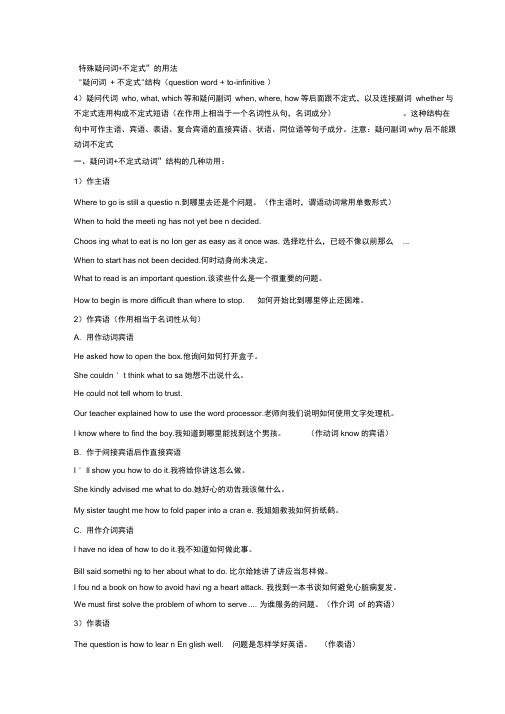
特殊疑问词+不定式”的用法"疑问词+ 不定式"结构(question word + to-infinitive )4)疑问代词who, what, which等和疑问副词when, where, how等后面跟不定式,以及连接副词whether与不定式连用构成不定式短语(在作用上相当于一个名词性从句,名词成分)。
这种结构在句中可作主语、宾语、表语、复合宾语的直接宾语、状语、同位语等句子成分。
注意:疑问副词why 后不能跟动词不定式一、疑问词+不定式动词”结构的几种功用:1)作主语Where to go is still a questio n.到哪里去还是个问题。
(作主语时,谓语动词常用单数形式)When to hold the meeti ng has not yet bee n decided.Choos ing what to eat is no Ion ger as easy as it once was. 选择吃什么,已经不像以前那么...When to start has not been decided.何时动身尚未决定。
What to read is an important question.该读些什么是一个很重要的问题。
How to begin is more difficult than where to stop. 如何开始比到哪里停止还困难。
2)作宾语(作用相当于名词性从句)A. 用作动词宾语He asked how to open the box.他询问如何打开盒子。
She couldn ' t think what to sa她想不出说什么。
He could not tell whom to trust.Our teacher explained how to use the word processor.老师向我们说明如何使用文字处理机。
初中英语动词不定式用法梳理

初中英语动词不定式用法动词不定式是由“不定式符号to+动词原形”构成的一种非谓语动词结构。
有些动词不定式不带to,动词不定式可以作句子的主语、表语、宾语、定语、补语、状语或单独使用。
不定式保留动词的某些特性,可以有自己的宾语、状语等。
动词不定式和它后面的宾语、状语等一起构成短语,叫作不定式短语。
一、用作主语直接把动词不定式置于句首的情况不多,多数情况用it作形式主语,把真正的主语——动词不定式置于句末,特别是不定式短语较长时。
动词不定式作主语,谓语动词用第三人称单数形式。
.To see is to believe.(眼见为实;百闻不如一见)二、用作表语动词不定式作表语,常说明主语的内容、性质、特征。
如:1.The best way is to join an English club.1.可以接带to的动词不定式作宾语的动词主要有:要求选择同意(ask,choose,agree),期望决定学习(expect, hope, decide, learn),宁可假装知道(prefer, pretend,know),希望想要愿意(wish, want, would like / love)。
如:He prefers to eat white bread and rice.2.动词decide, know, learn, show, teach, tell...,介词结构on...可用疑问词带to的不定式短语作宾语,但why后面的不定式不带to。
如:Could you please tell me where to park my car?3.动词feel, find, make, think等后面,可以用it作形式宾语代替真正的宾语——动词不定式,句子结构是...feel / find / make / ... it+adj. / n.+to do...。
如:I find it difficult to remember everything.4.既可接动词不定式又可接ving形式作宾语,意思差别不太大的动词有begin,start, like, love等。
- 1、下载文档前请自行甄别文档内容的完整性,平台不提供额外的编辑、内容补充、找答案等附加服务。
- 2、"仅部分预览"的文档,不可在线预览部分如存在完整性等问题,可反馈申请退款(可完整预览的文档不适用该条件!)。
- 3、如文档侵犯您的权益,请联系客服反馈,我们会尽快为您处理(人工客服工作时间:9:00-18:30)。
谈疑问词+动词不定式的用法
在英语中,疑问词+动词不定式的用法较为普遍,现在将其归纳如下:
“疑问词+动词不定式”结构中的疑问词,包括疑问代词what which who和疑问副词when how where 等。
这些疑问词和不定式一起构成了不定式短语,这种结构在句子中除了不能作谓语外,可做主语、宾语、表语等。
例如:
1. She didn’t know which bus to take.她不知乘哪路公共汽车。
(做动词宾语)
We must first solve the problem of whom to serve.我们必须首先解决为谁服务的问题。
(做介词宾语)
2. When to start remains undecided.何时出发,尚未决定。
(做主语)
3. The difficulty is how to do the most of work with the least of money.困难是如何尽量少用钱多办事。
(做表语)
这种结构相当于一个名词从句,不论它在句子中做什么成分,常常都可用同等成分的从句替代。
改为从句时只要在疑问词后面填加一个适当的主语并将不定式动词改为适当形式的谓语既可。
所以上述几句可分别改成:
She didn’t know which bus she should take.
We must first solve the problem of whom we should serve.
When we should start remains undecided.
The difficulty is how we ought to do the most of word with the least of money.
当这种结构做宾语的时候,常常置于show, find out, learn, teach, tell, advise, wonder, know, discuss, remember, forget, explain 等动词之后。
例如:The dictionary didn’t tell the Frenchman how to pronounce the word .
那本词典没有告诉那个法国人怎样读那个词。
The teacher showed us how to read a book. .
老师指点我们怎样读书。
She hore I’ll advise her which to choose.
她希望我建议她选择哪一个。
You’d better find out where to put these pens.
你最好了解一下应把这些钢笔放在哪里。
另外,值得注意的是在动词know 的后面一般用带疑问词的不定式做宾语:
误:I know to say them in English.
正:I know how to say them in English.
在下面的句子中,含有“疑问词+动词不定式”结构的,其中的told 有taught的意思,不含有这种结构的,其中的told 有ordered 的意思。
例如:
The professor told the students how to do the experiment.
这位教授教学生们如何做实验。
The professor told the students to do the experiment at once.
这位教授要学生们立刻做实验。
像这种结构的还可以独立成句。
例如:What to do?
怎么办?
How to get rid of the trouble? 如何摆脱困境?。
